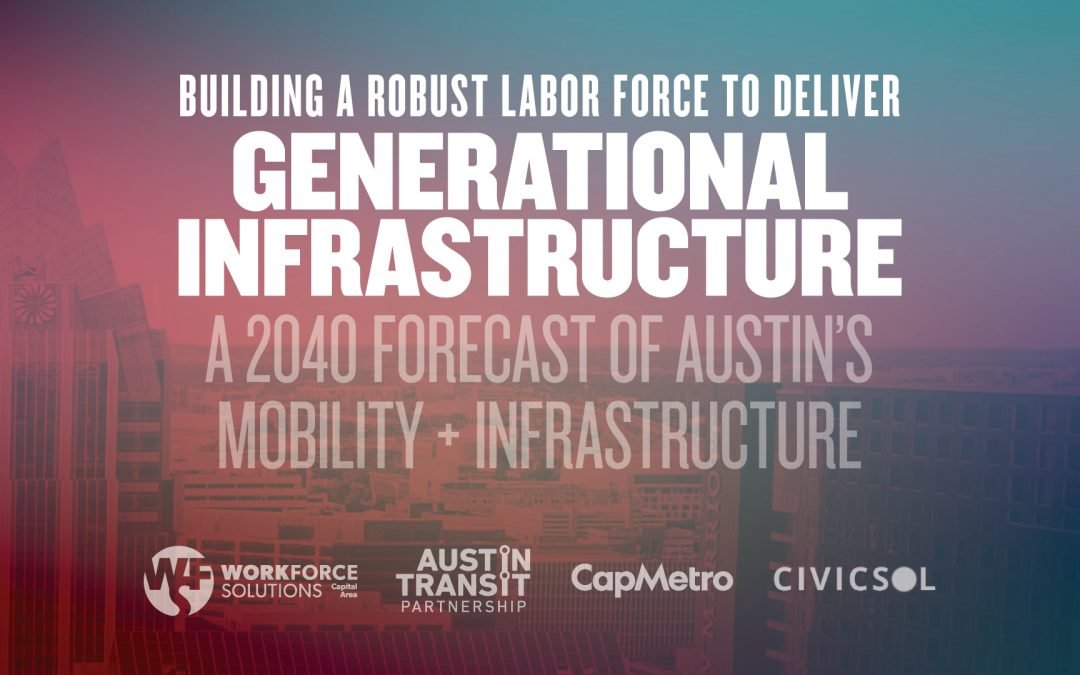Considering the imminent arrival of several large-scale projects, Austin must prepare itself for the heightened demand for M+I workers. Building A Robust Labor Force to Deliver Generational Infrastructure is Central Texas’ first-ever labor and demand forecast for the mobility and infrastructure (M+I) sector, initiated to inform the region’s action plan for connecting local people to the thousands of jobs and careers created by the M+I industries.
Why it matters: With the investment in transformational regional infrastructure, we can address Austin’s affordability challenges by creating family-supporting jobs and sustainable career pathways, while improving regional mobility.
- Austin can cultivate a strong and skilled labor force capable of undertaking these large-scale mobility and infrastructure projects, thereby redefining economic development prospects to foster prosperity for all.
Big picture: Austin, now the ninth-largest city in the nation, has grown by 14% in the past five years, sparking increased demand for new housing, improved roads, and other infrastructure enhancements.
- This rapid expansion underscores the critical need for a robust M+I workforce, equipped to manage, supervise, and construct infrastructure projects.
- Currently, Austin’s M+I sector employs over 222,000 workers, positioning it as the region’s second-largest sector, surpassing both healthcare and advanced manufacturing.
Zoom out: The M+I industry has gained significant national attention, with the implementation of the Bipartisan Infrastructure Law, the Inflation Reduction Act, and the CHIPS and Science Act, resulting in a historic investment of $2.5T.
- A significant portion of this funding, approximately $500 billion, is allocated to infrastructure projects and is closely linked to workforce development.[1] Consequently, the M+I industry urgently requires a forward-looking workforce development system.
- Approximately 1.7M workers leave their positions annually, highlighting the substantial efforts needed to fill these vacancies. The recent federal legislation is anticipated to generate an additional 1.5M jobs annually.[2]
- Of note: The industry has been criticized for its lack of inclusivity towards younger workers, women, and people of color. Therefore, inclusive training programs targeting non-traditional populations and providing access to well-paying jobs are imperative to meet the escalating demand for projects.
Bottom line: Our research provides crucial insights into the M+I sector by examining the existing capacity of Austin’s M+I workforce, forecasting its growth trajectory until 2040, and presenting solutions that exist both nationally and within the region to fortify the workforce development ecosystem.
The 10 most relevant trends for defining the current gaps and future opportunities in the M+I sector are:
- 10,000 M+I jobs created annually through 2040.
- The region’s existing skill shortages could hamper project success.
- Even the deepest wells of talent will be spread thin.
- A 4,000 annual training gap could exacerbate skill shortages.
- 6 in 10 M+I workers earn a prevailing wage.
- Women account for only 14% of the M+I workforce.
- Automation is set to impact M+I jobs more significantly than most other sectors.
- Employers seem to be disconnected from the skilled trade talent pool within the region.
- There is no consistent standard training period for the region’s M+I training initiatives.
- Present-day recruiting methods in the M+I sector are limited.
GO DEEPER:
If you are a job creator who recruits for roles or coordinates contracts or training for jobs in the M+I landscape — everything from transit operators to mechanics and engineers — your voice is needed. Sign up to learn more about the industry sector partnership and to join us for future work sessions.
Workforce Solutions Capital Area is on point to gauge how our community meets the moment and fills the roles this burgeoning economic sector will require, alongside Austin Mayor Kirk Watson, Travis County Judge Andy Brown, and their appointed Mobility & Infrastructure Leadership Group. An action plan is in development by the Leadership Group to bring thousands more residents into M+I jobs in our region. One of the first action items from this partnership was to deliver this research study.
[1] Ross, Martha, Joseph Kane, Felix Laniyan, and Annelies Goger. “How State and Local Leaders Can Harness New Infrastructure Funding to Build a Stronger, More Inclusive Workforce.” Brookings, March 24, 2023. https://www.brookings.edu/research/how-state-and-local-leaders-can-harness-new-infrastructure-funding-to-build-a-stronger-more-inclusive-workforce/.
[2] Kane, Joseph. “Seizing the U.S. Infrastructure Opportunity: Investing in Current and Future Workers

